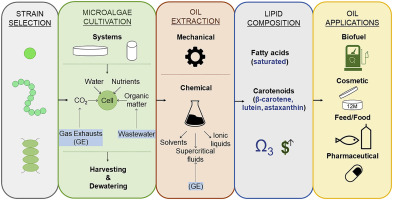Renewable and Sustainable Energy Reviews ( IF 16.3 ) Pub Date : 2019-04-23 , DOI: 10.1016/j.rser.2019.04.052
G.F. Ferreira , L.F. Ríos Pinto , R. Maciel Filho , L.V. Fregolente

|
Microalgae are potential sources of high-value lipids, with essential fatty acids that provide health benefits, as the omega-3 polyunsaturated fatty acids. However, its cultivation and downstream processing is still not commercially viable for some applications due to high-water consumption and high costs mainly regarding energy demands and nutrients as nitrogen. Therefore, using waste streams in existing industries as carbon and nutrient sources, as well as evaluating the best methodologies for growth and lipid extraction are essential to viabilize this process. This review focused on the study of scenario the of using different microalgae species, integrating their cultivation into biorefineries using their wastewater and carbon dioxide combating water and air pollution, aiming lipid productivity and fatty acid profile with specific composition. It was found that culture medium conditions and cultivation systems are key elements in understanding the lipid production and can decisively affect the process performance. For example, closed photobioreactors with CO2 supply and light can provide higher photosynthetic efficiency and lipid accumulation, coupled with polyunsaturated fatty acid production. Wastewater use can reduce productivity and affect lipid composition, but CO2 injection can promote both higher biomass and lipid productivities; being Chlorella a potential candidate for implementation in industrial facilities once it showed high PUFA (around 1/3) and lipid content, up to 27%, grown in wastewater. Moreover, it is crucial to seek biomass fractioning to obtain different high-value products that will compensate for high capital and operating costs. Further evaluation of possible effects in the final product quality is required.
中文翻译:

从微藻类生产脂质的综述:利用废料流培养与脂肪酸谱之间的关联
微藻是高价值脂质的潜在来源,其中的必需脂肪酸可提供健康益处,例如omega-3多不饱和脂肪酸。然而,由于高耗水和高成本(主要是关于能源需求和营养物作为氮),其栽培和下游加工在某些应用上仍不具有商业可行性。因此,利用现有工业中的废物流作为碳和营养源,以及评估最佳的生长和脂质提取方法,对于使该过程稳定化至关重要。这篇综述重点研究了使用不同微藻物种的情景研究,利用其废水和二氧化碳与水和空气污染作斗争,将其培养物整合到生物精炼厂中,以特定组成的脂质生产率和脂肪酸谱为目标。发现培养基条件和培养系统是理解脂质产生的关键因素,并且可以决定性地影响加工性能。例如,带有CO的封闭式光生物反应器2供应和光照可以提供更高的光合作用效率和脂质积累,再加上多不饱和脂肪酸的产生。废水的使用会降低生产率并影响脂质的组成,但是注入CO 2可以促进更高的生物量和脂质生产率。是绿藻在工业设施实施的潜在候选,一旦表现出较高的多不饱和脂肪酸(约1/3)和脂质含量,高达27%,增长废水中 此外,至关重要的是寻求生物质分馏以获得不同的高价值产品,这些产品将补偿高昂的资本和运营成本。需要对最终产品质量可能产生的影响进行进一步评估。































 京公网安备 11010802027423号
京公网安备 11010802027423号